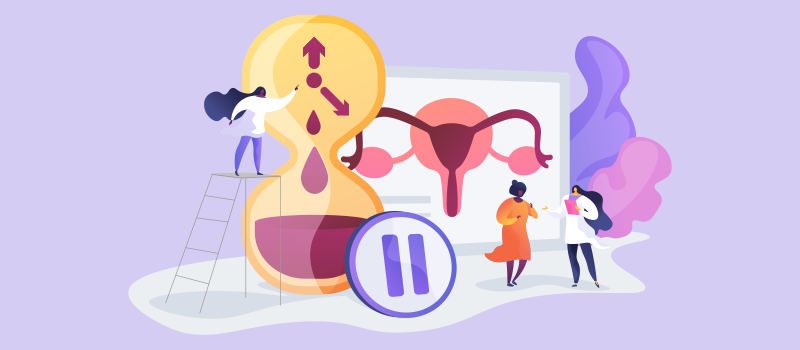What’s the Buzz
The Bee Healthy Blog
Low Estrogen Symptoms: Signs & Treatments

Estrogen is a sex hormone that is present in both males and females, although the female body has higher levels. Estrogen plays an important role in normal sexual development and reproductive functions in women as well as many bodily functions.
Estrogen levels fluctuate during the normal menstrual cycle. Also, women going through menopause make less estrogen and typically have low estrogen levels.
Consistently low estrogen levels in women who are not menopausal should be evaluated by a healthcare provider. In teenagers, low estrogen production can delay puberty and lead to problems with sexual development. In women of childbearing age, low estrogen levels can make it difficult to get pregnant.
Please continue reading to learn more about the common symptoms of low estrogen as well as treatment options for low estrogen levels.
What causes low estrogen?
The main causes of low estrogen levels are:
Menopause
In young women with a normal menstrual cycle, the ovaries produce estrogen. In postmenopausal women who have stopped getting their menstrual periods, there is a decline in estrogen production because the ovaries stop making the hormone (the fat cells in the body continue making estrogen).
Ovarian conditions
Ovarian cysts, radiation therapy to the ovaries, or surgical removal of the ovaries can be the underlying cause of low estrogen.
Other medical conditions
Other conditions such as eating disorders, kidney disease, autoimmune diseases, genetic conditions, and pituitary gland (endocrine system) problems can affect estrogen production and lead to low estrogen levels.
How can you tell if your estrogen is low?
Symptoms of low estrogen are also called menopausal symptoms because they frequently occur during perimenopause (around the time of menopause). These symptoms are the result of hormonal imbalances, specifically declining hormone levels (estrogen levels).
Common symptoms of low estrogen include hot flashes, night sweats, vaginal dryness, vaginal atrophy (thinning of the vaginal and uterine lining), weight gain, irregular periods, painful sex, dry skin, breast tenderness, brittle bones, mood swings, irritability, difficulty concentrating, headaches, urinary incontinence, urinary tract infections, decreased sex drive (low libido), mental health problems, fatigue, and trouble sleeping.
Should low estrogen be treated?
Low estrogen should be treated because it is linked to bone and heart health. Estrogen therapy can lower the risk of osteoporosis (low bone density). Additionally, estrogen affects cholesterol metabolism and glucose metabolism, and replacing estrogen in postmenopausal women can help to decrease the risk of cardiovascular disease.
However, estrogen therapy is not without risks. Hormone replacement therapy can lead to a greater risk of serious health conditions like blood clots, breast cancer, heart disease, heart attack, and stroke. These risks depend on age, the type of hormone therapy, the dose, and the duration of treatment. Other factors such as a person’s overall health and individual health risks also play a role.
Your healthcare professional can help you weigh the benefits versus risks of estrogen therapy. They can diagnose low estrogen with blood tests and tailor hormone therapy to your needs. Your provider will regularly reevaluate to ensure that the benefits of hormone replacement therapy outweigh the risks.
How can I raise my estrogen levels quickly?
The quickest way to raise estrogen levels and treat hormone imbalances is through hormone replacement therapy (HRT). This can be in the form of systemic hormone therapy (pills, patches, creams, gels, rings, and sprays). These products contain a higher dose of estrogen which is absorbed systemically (throughout the body). This type of estrogen therapy can help manage symptoms like hot flashes and night sweats. The primary hormone in these products is estrogen but they may also contain other hormones such as progestin or progesterone (this is called combination therapy).
Hormone therapy can also consist of vaginal estrogen products that contain a low hormone dose. This type of treatment helps with vaginal and urinary symptoms of low estrogen.
Can low estrogen be treated naturally?
The natural way to treat low estrogen is to eat a healthy, balanced diet, get regular moderate-intensity exercise, reduce stress, and get enough sleep. Plant-based therapies (phytoestrogens) have shown some modest benefits in controlling vaginal dryness and hot flashes, but more research is needed. Natural sources of phytoestrogens include legumes like soybeans, chickpeas, and lentils, nuts like peanuts, seeds like sunflower seeds and flaxseed, and fruits like berries, pears, apples, plums, and grapes.
In summary, low estrogen levels and menopausal symptoms can be managed with hormone replacement therapy. Still, it’s important to work with your healthcare provider to understand the benefits versus risks of this treatment. Your primary care provider or an expert in women’s health, reproductive health, or postmenopausal health can develop a customized treatment plan for you if you have low estrogen levels, keeping your specific symptoms in mind.
References:

SOCIAL